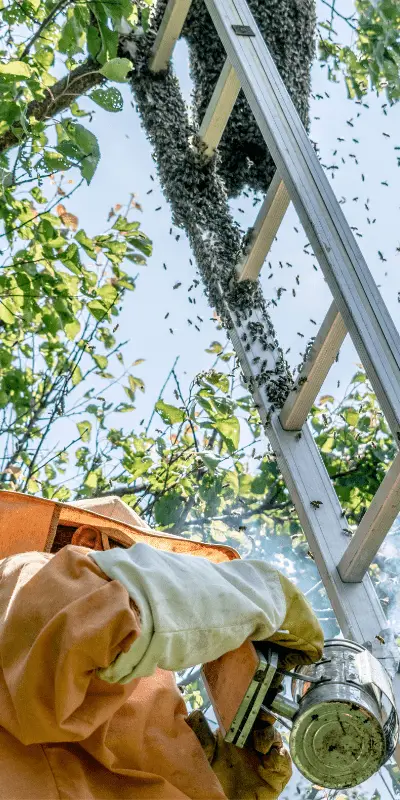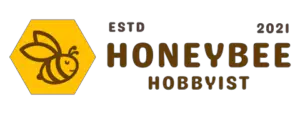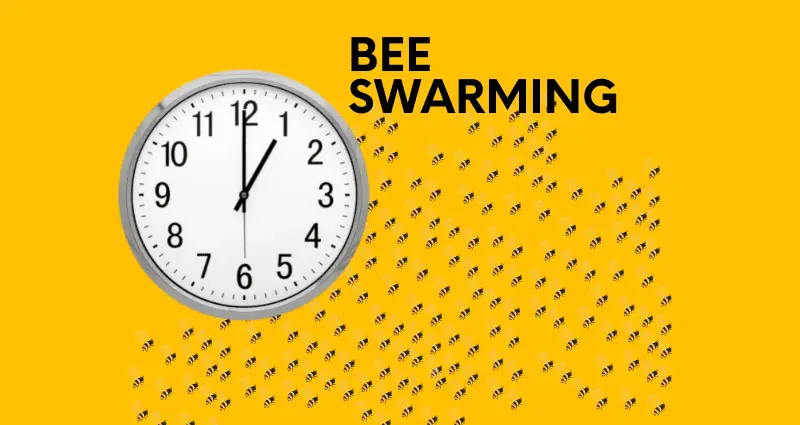Bees typically swarm between mid-morning and mid-afternoon. Not to be confused with bee bearding, swarming is a coordinated task bee colonies use to expand their colony. Once the temperature begins to drop, bees will return to the hive for the night.
Swarming is a natural activity that honey bees use to expand their colonies and ensure the sustenance of their species.
In the short run, swarming disrupts the brood cycle leading to a decline in overall productivity. But, local beekeepers can take advantage of capturing swarms within their neighborhood to gain new colonies and protect these pollinators instead of inhibiting their occurrence.
This article focuses on the swarming period to provide new beekeepers with essential insights into the phenomena.

What Time of Year Do Honey Bee Swarms Happen?
Typically, swarm season occurs in spring when plants are blooming, and there is abundant pollen and nectar for honeybees.
The plenteous forage causes the bee population to outgrow the hive size resulting in overcrowding. The congestion alerts the worker bees that the queen bee can no longer manage the expanded colony and will need to be replaced.
It takes two to three weeks to nurture a new queen, and the primary swarming occurs by late spring. If you closely monitor your apiary, you will see a cluster of bees absconding from it to a nearby tree branch.
Sometimes a beehive experiences secondary swarms where a virgin queen bee leads another cluster of bees to find a new location. Secondary swarms lack sufficient time to acquire enough forage for the upcoming winter, thus finding it difficult to survive.
How Do Honeybees Swarm?
Once crowding begins in a beehive, swarming becomes inevitable. The queen bee’s pheromones do not reach the entire workforce, making it difficult to control the colony.
In preparation for new queen bees, the workforce constructs swarm cells for the queen to lay eggs in them. The worker bees halt feeding the queen, instigating her to lose weight in anticipation of the swarm period. Temporarily, the queen stops laying eggs, and foraging reduces.
Swarming may ensue after the capping of queen cells and before the new virgin queens’ maturity. The old queen leaves with half of the workers to a transitory location near the original hive when the time reaches. The queen releases pheromones to signal the other bees to surround her.
A small bunch of scout bees leaves the cluster to look for a suitable location to create their new home. Within three days, the scout bees would identify a new hive for the bunch of bees to inhabit. The bees would fly to the new nest site and start over building the honeycomb, cultivating new broods, and collecting nectar and pollen.
In the brood hive, the remaining workers support the larva and pupa stages of the queens until the first queen emerges. Usually, the queen destroys the other queen cells to take over as the new queen. Then, she flies to locate mating drones and starts laying eggs to reconstruct the colony’s workforce.
How Can Beekeepers Capture a Swarm?
New beekeepers should constantly monitor their beehives to ensure any new swarms can be captured. This usually entails adding additional honey supers to allow the colony to expand and produce more honey.
Sometimes, the colony may become too large for a single queen to maintain. This is when splitting the hive makes the most sense.
Before swarming occurs, beekeepers can set a swarm trap or use a nuc box to capture the cluster of bees during the first instance they settle. Using a nuc box is ideal when sunny and bees are on a small tree or reachable branch.
- Put a white sheet below the cluster and place a nuc box on the sheet.
- Spray the bees with a sugar solution. It soaks the bees, preventing them from flying away, and protects you from bee stings.
- Energetically shake the branch.
Most bees will drop to the white sheet and enter the nuc box to hide. A good number of the cluster would have entered the nuc box in less than twenty minutes.
When capturing a wild swarm, a similar approach can be used.



